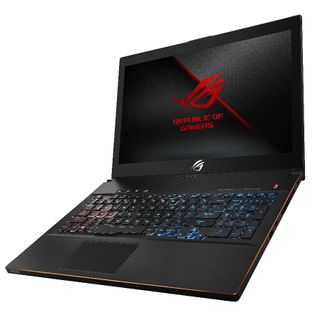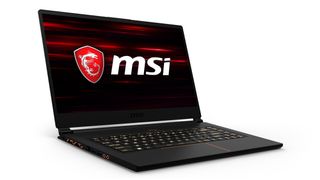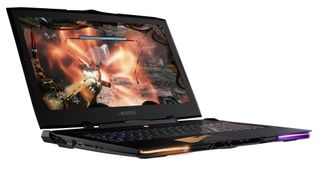First Coffee Lake Mobile Core i9, i7 Laptops Tested: Gaming & Battery Life
Intel's new Coffee Lake processors bring up to six cores and 12 threads to notebooks, setting a new bar for gaming- and workstation-class laptops. In another first, Intel's new Thermal Velocity Boost allows the Core i9-8950HK to boost up to 4.8 GHz if the processor falls beneath a 50C temperature threshold. That's the highest boost frequency of any of Intel's processors (desktop models included), which should provide leading performance in some game titles. It also puts the onus on each new laptop's thermal solution to allow for higher clocks.
The new processors debuted in a wide range of laptops today. Our colleagues at our sister site Laptop Mag have been busy testing the latest and greatest gaming models. So we've grabbed a few of their benchmarks for a quick look at battery life and gaming performance. Be sure to head to each review (linked in the text below) to get the full Laptop Mag rundown.
The Contenders
ASUS's ROG Zephyrus M comes packing Intel's flagship Core i7-8750H processor paired with 16GB of DDR4-2666 RAM. The six-core 12-thread processor has a relatively mundane 2.2 GHz base frequency, but it boosts up to 4.2 GHz during lightly threaded workloads. A full-fledged Nvidia GeForce GTX 1070 with 8GB of VRAM drives the 15.6" G-Sync-capable 1920x1080 (144Hz) display. This model comes with a $2,199 price tag, but you can find a less expensive Newegg-specific model that comes equipped with a GeForce 1060 for $1,899.
MSI's GS65 Stealth comes with the same Core i7-8750H processor as the ROG Zephyrus, plus a similar 16GB of DDR4-2666 RAM. An Nvidia GeForce GTX 1070 Max-Q GPU drives the 15.6" 1920X1080 144Hz display. This model is priced at $1,999, but you can step down to less-capacious storage and an Nvidia GeForce GTX 1060 for $1,799.
The Gigabyte Aorus X9 brings the pain with Intel's flagship Core i9-8950HK and an Nvidia GeForce GTX 1080. But you'll feel most of that pain in your wallet when you shell out $3,899 to take one home. Your reward is Intel's flagship mobile processor, which boasts a base frequency of 2.9 GHz and an impressive 4.8 GHz boost. The 17.3" 144Hz 1080p panel supports G-Sync, but our colleagues found the display to be a bit dim. This flagship-class laptop is Gigabyte's lone configuration for now.
Again, head over to the linked reviews for a much deeper look at the notebooks. Also, head over to Laptop Mag's How We Test article for a closer look at the test methodology.
It All Starts With The Battery
The burning question on our minds--and perhaps in our laps--is how much power a six-core, twelve-threaded beast is going to draw. Naturally, higher power draw will equate directly to shorter battery life.
Stay on the Cutting Edge
Join the experts who read Tom's Hardware for the inside track on enthusiast PC tech news — and have for over 25 years. We'll send breaking news and in-depth reviews of CPUs, GPUs, AI, maker hardware and more straight to your inbox.
Laptop Mag's custom test replicates continuous Web surfing over Wi-Fi until the battery is completely drained. Starting with a full battery, a notebook runs a script that visits 12 different types of web pages in a loop, pausing for 30 seconds to 3 minutes before advancing to the next page. The test is run with the screen at 150 nits (as measured by the XRite colorimeter), and the notebook's settings are tweaked to prevent it from entering sleep or dimming the screen.

Laptop Mag generates an average score of all laptops that fall into a similar class, and then uses it to provide a general indicator of how the new laptops compare to the aggregate score.
The category average weighs in at three hours and 49 minutes of battery life, which the MSI GS65 easily beats with five hours and forty minutes of battery life. That model comes equipped with the same Core i7-8750H processor as the Asus ROG Zephyrus M, but the Zephyrus falls well below the category average with two hours and 47 minutes of battery life. The Zephyrus' beefier GTX 1070 likely plays a big role in the reduction, but it also has a much smaller 55WH battery than the GS65's 82WH battery.
You'll pay a premium for the Core i9-equipped Aorus X9 and its GTX 1080 that are paired with the expansive 17.3" display, but you'll also pay a power tax. This laptop comes equipped with a beefy 94WH battery--the largest of the bun--but it delivers only two hours and 20 minutes of battery time. Laptop Mag's recommendation is simple: you should probably keep this laptop close to an outlet.
Gaming Performance
We don't expect world-beating battery life from these high-performance laptops, but we certainly expect great gaming performance from the higher clocks and more cores Intel's latest chips provide.







Synthetic benchmarks are great because they tend to scale linearly with increased CPU and GPU horsepower, but that doesn't always equate directly to performance in more common game titles. 3DMark's test suite certainly falls into that category, but its real usefulness lies in measuring the amount of performance available to the game engine, thus giving us a peek into what highly-optimized games could be capable of.
It's no surprise to find the Aorus X9 taking a healthy lead in the Ice Storm Unlimited benchmark, but that gap widens as it absolutely slays the competition in the 3DMark Fire Strike test. The advantages of the higher-clocked 6C/12T Core i9 really shine through here, and having the more powerful GTX 1080 in the arsenal certainly pays dividends, even if it does also come at the expense of battery life.
VR titles tend to prize performance in lightly threaded workloads, so higher clock speeds and IPC throughput tend to set the bar. It's somewhat surprising, then, that the Alienware 15 R3 with its Kaby Lake Core i7-7820HK and GTX 1070 can stay in the game here. Ultimately, this may just be a reminder that while the Core i9 series is a formidable beast by itself; wrapping it up in a slim notebook form factor could hinder its boost speeds if the thermal solution isn't bulky enough.
We return to more of the expected in Rise of the Tomb Raider, which finds the Aorus leveraging its capable CPU and graphics subsystem to carve out a nice lead against competing laptops. Grand Theft Auto V and Metro Last Light, which also scale equally well with host compute, tell a similar tale.
The Zephyrus and GS65 aren't quite as competitive with the previous-generation models as we expected. We also spotted the surprisingly-capable Alienware 15 R3 take a slight lead over the Aorus X9 in Hitman, but it runs out ahead of the Zephyrus and GS65, serving as yet another reminder that gaming laptop performance is about so much more than just the CPU and graphics. A holistic design with a capable cooling system really pays off, especially when it squares up against systems with much more capable hardware. And it's a lot easier to fit powerful cooling in a laptop design that isn't also striving to be as thin as possible.
Overall, Laptop Mag's first outing with the new mobile Coffee Lake CPUs leaves us impressed, but we'll need a broader examination of the avalanche of new laptops--and the ability to run our own tests--to draw any definitive conclusion about the overall ecosystem.

Paul Alcorn is the Managing Editor: News and Emerging Tech for Tom's Hardware US. He also writes news and reviews on CPUs, storage, and enterprise hardware.
-
Olle P Nothing really surprising here. The new high end CPUs are throttled by the 45W limit and limited space/volume for cooling.Reply
Better suited for (relatively) thick laptop designs, and it will also be interesting to see how they perform when all threads can be fully utilised. -
zodiacfml I'm confident this will be the last of 14nm chips Intel has been releasing for years. The core counts sounds impressive but it will be 8-14 months and we'd start seeing the 10nm mobile parts with the same core counts with longer boost frequency durations.Reply -
Giroro I'm curious to see temperatures and maybe a teardown of the cooling in i-9 laptops - considering the desktop i-9s were edging into "impossible to air cool" territory.Reply
I wonder if the laptop i-9s would actually perform any better if you hack together some ideal cooling on a test bench. Is it thermal throttling, or have has the clock simply been reduced too badly just to fit in those extra generally-useless-for-gaming cores. -
george_osborne A lot of apples to oranges here. The Aorus has a 1080 vs 1070 in the and 32GB vs 16GB. The PCie SSD may also be faster than the others, no mention of read/write speeds. You would expect better graphics and overall performance with that hardware edge, but then you get what you pay for and the price is almost twice as much. You do, still, (usually) get what you pay for.Reply
Most Popular





